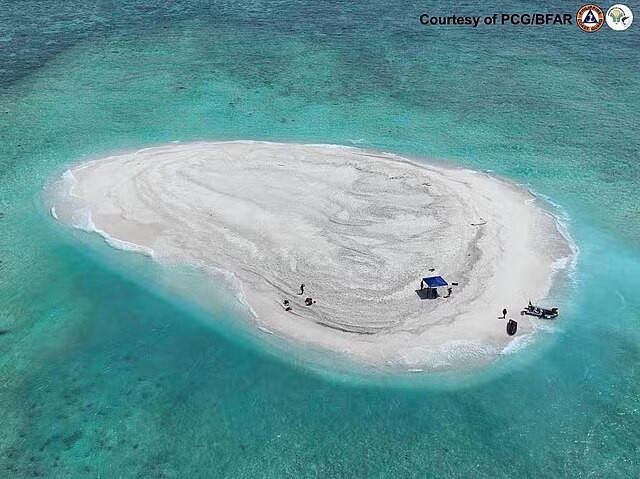Tensions between China and the Philippines escalated this week after both countries unfurled their national flags on the disputed Sandy Cay sandbars in the South China Sea, intensifying a long-running territorial dispute in one of the world's most strategic waterways. The rival moves come as U.S. and Philippine forces conduct their largest-ever joint military exercises nearby.
Chinese state broadcaster CCTV aired footage showing four Chinese Coast Guard officers in black uniforms landing on Sandy Cay, holding their flag aloft in a display of sovereignty. The broadcaster reported that Chinese personnel conducted patrols, cleaned up debris, and "exercised sovereign jurisdiction" over the reef, referred to as Tiexian Reef by China.
In response, the Philippines swiftly launched a counteroperation. Jay Tarriela, spokesperson for the Philippines Coast Guard, confirmed that four Philippine teams landed on the sandbars, raised their national flag, and found no evidence of any Chinese installations or monitoring devices. "We can totally debunk the lie and disinformation the People's Republic of China that they have already occupied the Pag-asa cays," Tarriela stated at a press conference Monday.
National Security Council spokesperson Jonathan Malaya emphasized that reports suggesting China had seized Sandy Cay were "false" and "irresponsible." "We are here to debunk that and to assure the public that we have not lost the Pagasa Cays," Malaya said.
The competing flag-raising ceremonies underscore the broader contest for control of the South China Sea, where China has claimed nearly the entire region, defying a 2016 international tribunal ruling. Over the past two decades, Beijing has transformed obscure reefs into fortified military outposts with runways, missile systems, and ports.
Sandy Cay lies close to Thitu Island, known as Pag-asa Island in the Philippines, where Manila maintains a military outpost. In 2023, the Philippines opened a coast guard monitoring base there to counter what it described as "Chinese aggression."
The latest episode comes as the U.S. and the Philippines launched their annual "Balikatan" joint drills, involving thousands of troops and, for the first time, a U.S. anti-ship missile launcher deployed on Luzon's northern tip, near Taiwan. Japanese forces also joined as full participants for the first time.
U.S. Defense Secretary Pete Hegseth, visiting Asia last month, vowed to strengthen America's alliance with the Philippines to "reestablish deterrence" against China. Secretary of State Marco Rubio similarly stressed the need to "push back" on Chinese expansionism.
China's Foreign Ministry responded Monday, saying its activities at Sandy Cay were aimed at "countering illegal actions" by the Philippines and ensuring that the reef "remains uninhabited and without facilities." Spokesperson Guo Jiakun insisted that Beijing "resolutely upholds the seriousness" of a 2002 regional agreement, which bars new occupation of uninhabited features.
The diplomatic clash adds to existing frictions. Philippine officials recently accused Chinese state-backed entities of meddling in the upcoming midterm elections-allegations Beijing denied. Both sides have also accused each other of spreading disinformation related to the South China Sea.
Meanwhile, the broader context of the confrontation underscores the South China Sea's vital importance: more than $3 trillion in global trade passes through the waterway each year, making any military flare-up a potential threat to international stability.






